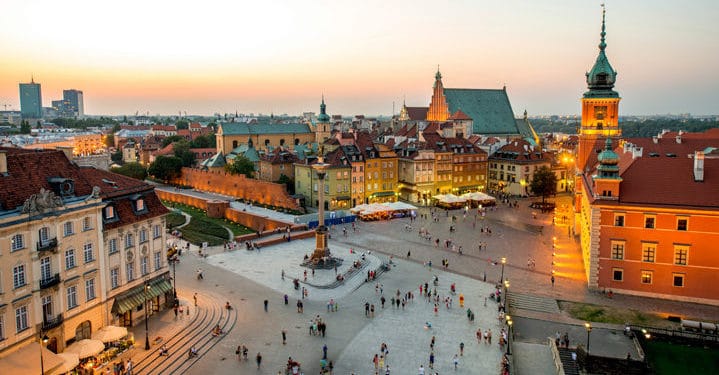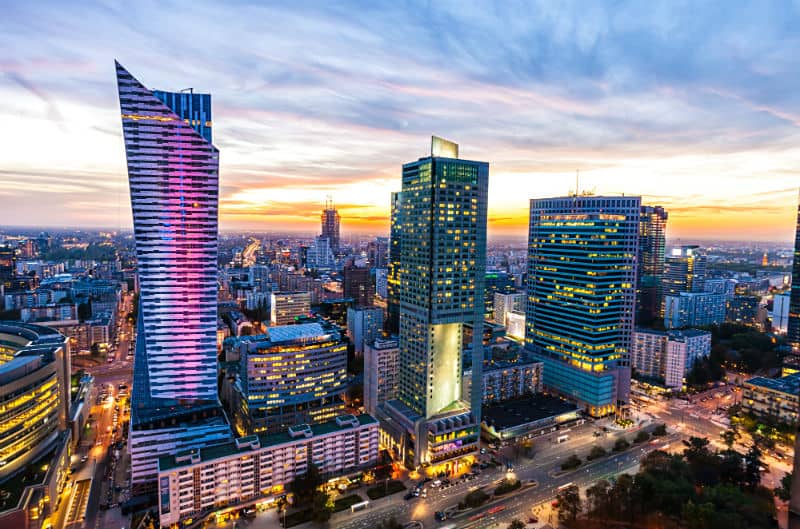
Gay Warsaw · City Guide
First visit to Warsaw? Then our gay Warsaw city guide page is for you.

Warsaw | Warszawa
Poland’s capital, home to almost 2 million people, is a rapidly developing European metropolis, with an urban skyline that has been transformed since the fall of communism in 1989.
The traditional tourist highlights around the Old Town now merge into a new modern European capital city, boasting many luxury high-rise hotels, an ever-growing cosmopolitan restaurant & bar culture and a steadily emerging gay scene.
Gay Rights in Poland
Homosexuality has never been illegal in Poland. In 1932, Poland legally recognised homosexuality and the age of consent is 15 for both gay and straight people. Poland remains one of a few countries where gay men are allowed to donate blood.
The influence of the Catholic Church has made the journey towards equal gay rights a slower process than in other parts of Europe. However, social attitudes are changing and becoming more accepting of gay rights.
Despite this, Poland is one of few remaining European countries without any form of legal partnerships for gay and lesbian couples. Adoption by gay or lesbian couples is not allowed, although single gay people can adopt.
Gay Scene
The gay scene in Warsaw is relatively small compared with most European capital cities, but it is steadily developing. More Gay Bars and clubs have opened in recent years, with rainbow colours proudly being displayed.
There is a thriving café culture with several gay-owned and many gay-friendly venues. Most cafés are located around Śródmieście, the city's central district and home to major tourist sights and hotels.
Warsaw staged its first-ever EuroPride celebration in 2010. While it did meet with some local opposition, it was a landmark event and a springboard that has helped the local LGBT community build a wider and more public profile.
Getting to Warsaw
By plane
Frédéric Chopin International Airport (WAW) is Poland's largest airport, located 10km south of the city centre. You can also fly into Warszawa Modlin.
There is a train connection from the airport to downtown Warsaw, with SKM's lines S2 and S3 taking you into the city centre with singles costing 3.40 PLN. KML trains also run to the city centre costing 6.80 PLN.
There are also good bus connections to Warsaw's main transport nodes including a night bus service with singles starting at 3.40 PLN. If you're taking a taxi, be sure to head for the official taxi rank. Taxi prices should be approximately 40 PLN into the city centre.
By train
Warsaw has excellent rail connections to other European capital cities by high-speed train. The Dworzec Centralny (Warszawa Centralna) station is the major downtown terminal.
Getting around Warsaw
Trams have been a major feature of Warsaw’s public transport system for many years and still make for an ideal, cheap and safe way to get around the city. There are 30 tram lines connecting the city.
The Warsaw Metro has two lines at present, which serves commuters rather than tourists. A second line is nearing completion which will link the centre of the city with the right bank of the Vistula river.
Buses are also available and are integrated with the other public transport systems. Day tickets start at 15 PLN.
 Financial Buildings Illuminated at Twilight
Financial Buildings Illuminated at Twilight
Where to Stay in Warsaw
For our list of recommended Warsaw hotels for gay tourists, visit the Gay Warsaw Hotels page.
Things to See & Do
Śródmieście - Warsaw's central district containing most of major tourist attractions.
Old Town - tourist heartland of the city, meticulously restored after the destruction of Word War II; well worth a stroll.
Old Town and New Town Squares - for musical and theatrical open-air performances throughout the summer months.
Palace of Culture & Science - a gift to the city from ‘the Soviet people” built in 1955 and still dominated the city centre with its Socialist Realist architecture; contains museums, cinema and a concert hall, with a viewing platform on the 30th floor.
National Museum - features interesting temporary exhibitions as well as permanent collections; recently hosted the “Ars Homo Erotica” exhibit of contemporary and historical homoerotic art.
Warsaw Rising Museum - Opened on the 60th anniversary of the Polish uprising, this museum is fitting tribute to the resistance of the Polish people to occupation in 1944.
Fryderyk Chopin Museum - regarded as Europe's most modern biographical museum, housed in a stunning baroque Palace; one of many tributes to Chopin, Poland’s most famous composer, who spent twenty years of his life in Warsaw.
National Stadium - landmark stadium built for the UEFA EURO championships in 2012.
Royal Castle - impressive historical museum and home to some of Rembrandt’s paintings.
Łazienki Park and Palace - landscaped gardens and a palace built on a island for Poland’s last monarch, King Stanislaw August Poniatowski.
Wilanów Park and Palace - a former Royal summer residence and fine example of European Baroque, with exquisite gardens which frame the Palace.
Teatr Wielki - perhaps the most impressive theatre and concert hall in the city. The huge ‘world theatre’ is Poland’s grandest opera and ballet theatre.
Museum of Modern Art - a new museum housed in a former furniture store, close to the Central Railway Station.
There are some popular gay summer destinations within easy reach of Warsaw:
Błota, is a riverside beach, some 10km south of the city centre. Riding a bicycle there should take around 40 minutes from the city centre. From Wał Miedzeszyński turn left into Sitowie, which is a bumpy gravel road.
Wybrzeże Gdyńskie at Most Grota Roweckiegois bridge is another gay-favorite summer destination and also a riverside beach.
When to Visit
Warsaw attracts most visitors from May to September when the weather is at its best. Summers can be hot but also wet. The winter months from November to March can be very harsh, with a lot of snow and biting winds.
For more than a decade, the city has hosted an annual gay Pride event, with an associated music festival, parade and dance parties. Check the official Parada Równości website for future LGBT Pride plans.
Visa
Poland is within the European Schengen visa area. If you're travelling from outside Europe, check to see if you require a Schengen visa.
Money
Poland is not part of the Eurozone. The Polish currency is the złoty.
ATM's (bankomat) are easily found all around Warsaw. Visa, MasterCard, Visa Electron and Maestro are widely accepted.
Join the Travel Gay Newsletter
Have we got something wrong?
Are we missing a new venue or has a business closed? Or has something changed and we have not yet updated our pages? Please use this form to let us know. We really appreciate your feedback.